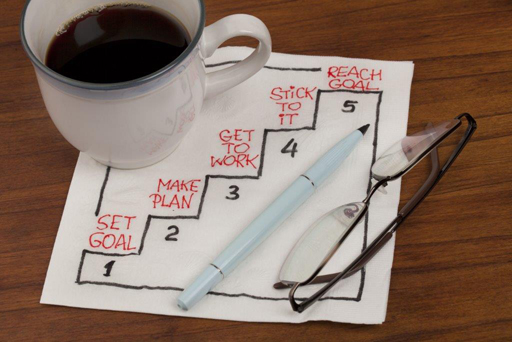3 Designing your action plan
It is all very well having visions and setting goals, but for them to have a high chance of success it is important to have a clear plan to follow. This does not mean you can’t change it later – everyone’s circumstances change – but it will help keep you on track.
Developing an action plan usually involves the following process, as outlined last week:
- setting yourself a goal to work towards
- working out what you need to do before you can achieve your goal – breaking the goal down into smaller chunks until you get to a point where you think, ‘Yes, that’s manageable. I feel I could tackle that.’
- putting the steps in a logical order – some will be dependent on others having been completed first, while some will be more flexible and can be completed at any time
- putting a timetable next to each step to spur you on to achieving that step.
You have already chosen your goal, so working out the ‘smaller chunks’ is the next logical stage. To help you think about this, here are some of the possible steps towards Mike and Charity’s long-term goals from Week 7:
Mike has no experience or qualifications for the restaurant business, so his ‘smaller chunks’ include finding out what is involved – identifying what qualifications he needs and how he could acquire them, preferably in his home town so that he has the support of friends and family while he does it – and working out the finances. He also has a short-term goal of getting some work experience to help decide whether being a chef would be as fulfilling as he hopes.
Charity decides she would like to confront her shyness by preparing and delivering a presentation to the local-history society. Before she had children, she had been researching her family tree, so this might be something she could talk about. To prepare her, as a first step, she decides she is going to work on her social skills by speaking to people she meets in the school playground while waiting for the children, rather than waiting for others to make the first move.
Did you notice that the steps they plan to take are designed around their own personal qualities, skills, knowledge and resources? Yours should be, too.
So now the next stage for you is to break your goal down into manageable steps – ones that fit with your personal qualities, skills, knowledge and resources and that you can tick off individually along the way.
Activity 3 Steps along the way
Try to think of at least three steps along the way to achieving your goal. The first one should feel like something you can really do in the very near future. Each step might depend on you completing the one before, or it may be free-standing.
Note these in your journal.
Discussion
- Do you see how each step could be seen as a smaller, short-term, goal?
- If you can make each one SMART, the chances of success are even greater.
Now you have all the information for drawing up an action plan for your chosen goal: your SMART goal itself, several steps along the way (preferably SMART too) and you should also have identified all the key helping and hindering factors related to your goal. So, let’s go!
Activity 4 Your action plan
Start a new page in your learning journal and lay out your action plan with the following headings.
My goal:
Date to achieve by:
Steps along the way (with dates):
Factors that should help:
Factors that might hinder:
How I might deal with the hindrances:
(Don’t forget to think about all the resources available to you, to help you address any hindrances.)
(You might even want to sign it – as a commitment to yourself!):

